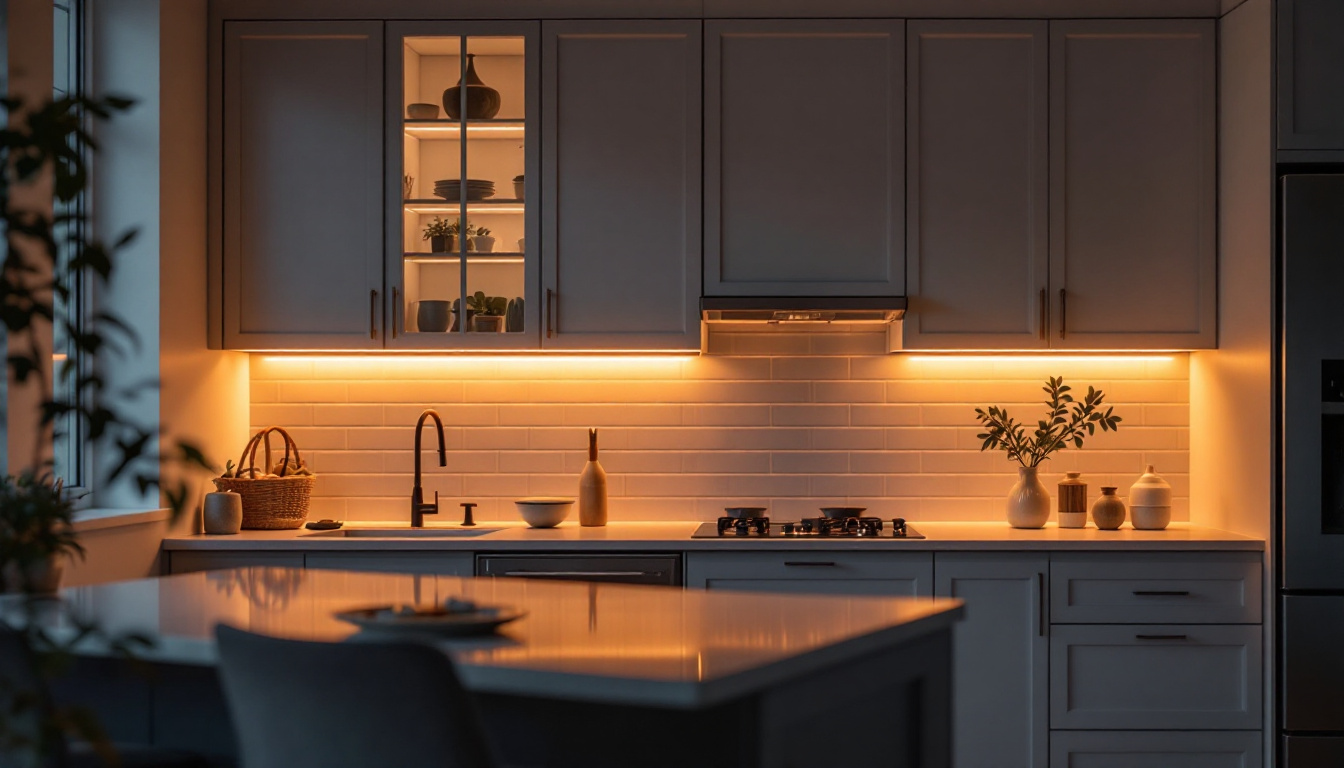
under cabinet LED lighting has become an essential element in modern kitchen design, providing both functionality and aesthetic appeal. For lighting contractors, understanding the nuances of this type of lighting can significantly enhance the quality of installations and client satisfaction. This article delves into the various aspects of under cabinet LED lighting, offering insights that every lighting contractor should consider.
Under cabinet lighting refers to fixtures installed beneath kitchen cabinets, illuminating countertops and workspaces. This type of lighting serves multiple purposes, from enhancing visibility while cooking to creating a warm ambiance in the kitchen. The choice of LED technology has transformed under cabinet lighting, offering energy efficiency, longevity, and versatility. Moreover, the aesthetic appeal of under cabinet lighting cannot be overlooked; it can highlight beautiful countertops, showcase decorative tiles, and add depth to the overall kitchen design.
LED lights are renowned for their energy efficiency. They consume significantly less power compared to traditional incandescent or fluorescent bulbs, making them an environmentally friendly choice. This efficiency translates to lower energy bills for homeowners, which is an attractive selling point for contractors. Additionally, LED technology allows for a range of color temperatures, from warm white to cool daylight, enabling homeowners to select the perfect ambiance for their cooking and entertaining spaces.
Furthermore, LEDs have a longer lifespan, often lasting up to 25,000 hours or more. This durability means fewer replacements and maintenance visits, which can enhance customer satisfaction and loyalty. The reduced heat output of LEDs is another significant advantage, as it minimizes the risk of overheating in confined spaces, ensuring that the kitchen remains a safe environment for food preparation. In addition, many modern LED fixtures come with dimming capabilities, allowing users to adjust the brightness according to their needs, whether they are hosting a dinner party or enjoying a quiet meal.
There are several types of under cabinet LED fixtures available, each with unique features and benefits. The most common types include strip lights, puck lights, and linear fixtures. Strip lights are flexible and can be cut to fit specific lengths, making them ideal for custom installations. They can be easily mounted in tight spaces and are perfect for illuminating narrow areas where traditional fixtures might not fit. Puck lights, on the other hand, are small, round fixtures that can be used to create focused lighting in specific areas, such as above a cutting board or near a sink, providing targeted illumination exactly where it is needed.
Linear fixtures provide a sleek, modern look and are often used for more uniform lighting across longer surfaces. These fixtures can be installed in a continuous run, creating a seamless line of light that enhances the overall design of the kitchen. Additionally, some linear fixtures come with integrated smart technology, allowing homeowners to control the lighting through mobile apps or voice commands. Understanding the differences between these types can help contractors recommend the best solutions for their clients’ needs, ensuring that each kitchen not only looks beautiful but also functions efficiently for everyday use.
Proper installation is crucial for maximizing the effectiveness of under cabinet LED lighting. Contractors should consider several factors, including the layout of the kitchen, the height of the cabinets, and the specific needs of the homeowner.
Before installation, it is essential to plan the layout of the lighting. This involves determining the best locations for fixtures to ensure even illumination across the countertop. It is also important to consider the type of tasks that will be performed in the kitchen, as this can influence the intensity and placement of the lights.
For example, areas where food preparation occurs may require brighter lighting, while areas used for dining may benefit from softer, more ambient lighting. A well-planned layout not only enhances functionality but also contributes to the overall aesthetic of the kitchen.
Lighting contractors should be knowledgeable about wiring requirements for under cabinet LED lighting. Most fixtures operate on low voltage, which may necessitate the installation of a transformer. It is essential to ensure that the power supply is adequate for the number of fixtures being installed to prevent overloading the circuit.
Additionally, contractors should consider the location of outlets and switches. Installing a dimmer switch can provide homeowners with the flexibility to adjust the brightness according to their needs, enhancing the overall user experience.
Color temperature plays a significant role in the ambiance of a kitchen. Measured in Kelvin (K), color temperature can range from warm (around 2700K) to cool (above 5000K). For under cabinet lighting, a color temperature of 3000K to 4000K is often recommended, as it provides a balance between warmth and clarity.
Warm lighting creates a cozy and inviting atmosphere, making it suitable for kitchens that serve as gathering spaces. This type of lighting is often preferred in homes with traditional or rustic decor. On the other hand, cool lighting offers a more modern and sleek appearance, which can complement contemporary kitchen designs.
Contractors should discuss color temperature options with their clients, as personal preferences can vary significantly. Providing samples or visual aids can help clients make informed decisions.
The Color Rendering Index (CRI) measures a light source’s ability to accurately render colors compared to natural light. A higher CRI (above 90) is ideal for kitchens, as it allows homeowners to see the true colors of their food and surroundings. When selecting LED fixtures, contractors should prioritize those with a high CRI to ensure optimal performance.
As energy efficiency becomes increasingly important to homeowners, lighting contractors should emphasize the sustainability benefits of LED under cabinet lighting. LEDs consume less energy and have a lower environmental impact compared to traditional lighting options.
While the initial investment in LED fixtures may be higher than that of traditional bulbs, the long-term savings on energy bills and maintenance costs can be substantial. Homeowners are often more inclined to invest in energy-efficient solutions when they understand the potential for cost savings over time.
Contractors can further enhance their value proposition by discussing available rebates or incentives for energy-efficient lighting upgrades. Many utility companies offer programs that can help offset the initial costs, making LED lighting even more appealing to clients.
LED lights are free of harmful substances such as mercury, which is commonly found in fluorescent bulbs. This makes them a safer choice for both the environment and the health of the occupants. By promoting the environmental benefits of LED lighting, contractors can align themselves with the growing trend toward sustainability in home design.
Staying updated on the latest trends in kitchen lighting design can help contractors provide innovative solutions that meet their clients’ expectations. Under cabinet lighting continues to evolve, with new styles and technologies emerging regularly.
Smart home technology is increasingly influencing kitchen lighting design. Many homeowners now seek under cabinet lighting that can be controlled via smartphone apps or voice-activated devices. This allows for greater convenience and customization, enabling users to adjust lighting settings based on their preferences or routines.
Contractors should familiarize themselves with available smart lighting products and their compatibility with existing home automation systems. Offering smart lighting solutions can set contractors apart in a competitive market.
Layered lighting is a design approach that combines different types of lighting to create a balanced and functional environment. Under cabinet lighting is often used in conjunction with ambient lighting (such as ceiling fixtures) and task lighting (like pendant lights) to achieve a cohesive look.
Contractors should consider how under cabinet lighting can complement other lighting elements in the kitchen. By creating a layered lighting scheme, they can enhance both the functionality and aesthetics of the space.
While LED lights are known for their longevity, occasional maintenance and troubleshooting may still be necessary. Contractors should be prepared to assist clients with common issues that may arise with under cabinet lighting.
One common issue is flickering lights, which can be caused by a faulty connection or incompatible dimmer switches. Contractors should educate clients on the importance of using compatible components to avoid such problems. If flickering occurs, checking connections and replacing dimmer switches with ones designed for LED use can often resolve the issue.
Another issue may involve uneven lighting. This can occur if fixtures are not installed at the correct height or if there are obstructions blocking the light. Contractors should be proactive in ensuring proper installation and addressing any concerns clients may have about lighting performance.
While LED lights require less maintenance than traditional bulbs, it is still important for homeowners to keep fixtures clean and free from dust. Contractors can provide clients with simple cleaning tips to help maintain optimal lighting conditions. Regularly checking connections and ensuring that the power supply is functioning correctly can also help prevent issues.
Under cabinet LED lighting is a vital component of modern kitchen design, offering both functionality and style. For lighting contractors, understanding the various aspects of this lighting solution can lead to successful installations and satisfied clients. By staying informed about installation techniques, energy efficiency, design trends, and maintenance, contractors can position themselves as experts in the field.
As the demand for under cabinet lighting continues to grow, contractors who embrace these insights will be well-equipped to meet the evolving needs of homeowners, ensuring that kitchens remain bright, inviting, and efficient spaces.
Ready to elevate your kitchen under cabinet LED lighting installations with the finest products on the market? Look no further than LumenWholesale, where we provide lighting contractors with spec-grade lighting solutions at unbeatable wholesale prices. Our commitment to quality and affordability ensures that you can deliver exceptional value to your clients without compromising on performance. With our vast selection, free shipping on bulk orders, and no hidden fees, you’re guaranteed to find the perfect lighting for any project. Don’t miss out on the best value in wholesale lighting. Explore our products now and light up your next installation with confidence.

Explore how low voltage electrical connectors are revolutionizing the lighting industry, offering lighting contractors enhanced safety, efficiency, and flexibility.

Explore the essentials of recessed lighting compliance in this insightful guide for lighting contractors.

Discover the ultimate guide to the 4.5-W-60 bulb, tailored for lighting professionals.

Discover essential tips for lighting contractors to avoid common pitfalls when working with LED light panels.